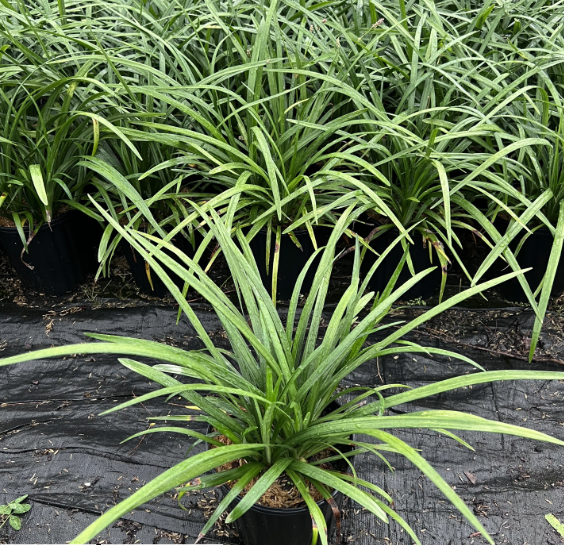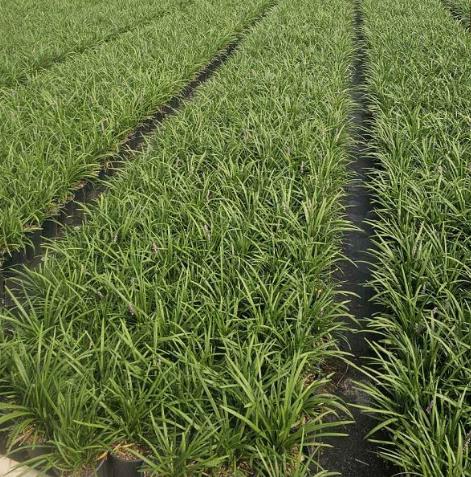Oakland Shade Trees & Nursery
Liriope muscari 'Big Blue' Lilyturf
Liriope muscari 'Big Blue' Lilyturf
Couldn't load pickup availability
Liriope muscari 'Big Blue' Lilyturf Description and Planting Guide
Description
Liriope muscari 'Big Blue,' commonly known as Big Blue Lilyturf or Monkey Grass, is a versatile, evergreen perennial valued for its lush, grass-like foliage and vibrant flower spikes. This cultivar forms dense, clump-forming mounds of dark green, strap-like leaves, growing to a height of 12 to 18 inches and a spread of 12 to 15 inches. In late summer to early fall, it produces striking spikes of lavender-purple, bell-shaped flowers that rise above the foliage, followed by small, black berries. Native to East Asia, particularly China, Japan, and Korea, 'Big Blue' is prized for its adaptability, low maintenance, and ability to thrive in a variety of conditions. Its tidy appearance and durability make it a popular choice for ornamental landscaping.
Why Plant Liriope muscari 'Big Blue' in a Landscaping Project?
Versatile Groundcover: Its dense, spreading habit makes it ideal for groundcover, filling in bare areas under trees, along slopes, or in borders, preventing soil erosion and suppressing weeds.
Low Maintenance: 'Big Blue' requires minimal care once established, tolerating drought, heat, and poor soils, making it perfect for busy homeowners or low-maintenance landscapes.
Year-Round Interest: The evergreen foliage provides consistent color, with vibrant summer flowers and berries adding seasonal appeal, enhancing garden aesthetics.
Shade Tolerance: It thrives in partial to full shade, making it an excellent choice for areas where other plants struggle, such as under trees or in north-facing gardens.
Edging and Borders: Its neat, compact growth is perfect for edging walkways, driveways, or garden beds, creating a polished, defined look.
Wildlife and Pest Resistance: 'Big Blue' is deer and rabbit resistant, reducing the need for protective measures, and attracts pollinators like bees with its flowers.
Grow Zone Information
Liriope muscari 'Big Blue' is hardy in USDA Hardiness Zones 5 to 10, thriving in a wide range of climates from cool temperate regions to warm subtropical areas. It performs best in areas with moderate summers and can tolerate winter temperatures as low as -20°F in Zone 5 with proper mulching. In hotter climates (Zones 9-10), it benefits from afternoon shade to prevent leaf scorch.
Planting Instructions
Site Selection:
Choose a location with partial shade to full shade for optimal growth, though it can tolerate full sun in cooler climates or with adequate moisture. Morning sun with afternoon shade is ideal in hot regions.
Select well-drained soil with a neutral to slightly acidic pH (6.0-7.0). It tolerates a range of soil types, including clay, loam, or sandy soils, but avoid waterlogged areas.
Spacing: Plant 12 to 18 inches apart for groundcover or mass plantings to allow clumps to merge over time. For borders or edging, space 8 to 12 inches apart for a tighter appearance.
Planting:
Timing: Plant in spring or early fall to allow roots to establish before extreme heat or cold.
Preparation: Dig a hole as deep as the root ball and twice as wide. Loosen soil and mix in compost to improve drainage and fertility if needed.
Placement: Set the plant in the hole with the crown level with the soil surface. Backfill with soil, pressing gently to eliminate air pockets.
Watering: Water thoroughly after planting to settle the soil.
Care After Planting:
Watering: Keep soil consistently moist but not soggy during the first growing season. Once established, 'Big Blue' is drought-tolerant but benefits from occasional deep watering during prolonged dry spells.
Mulching: Apply a 1- to 2-inch layer of organic mulch (e.g., bark or wood chips) around the base, keeping it away from the crown, to retain moisture and deter weeds.
Fertilizing: Apply a balanced, slow-release fertilizer (e.g., 10-10-10) in early spring to encourage healthy growth. Avoid over-fertilizing, which can lead to excessive foliage at the expense of flowers.
Pruning: In late winter or early spring, trim back dead or damaged foliage to 2-3 inches above the ground to rejuvenate the plant and promote fresh growth. Use clean, sharp shears.
Division: Every 3-4 years, divide clumps in spring to maintain vigor or propagate new plants. Dig up the clump, separate into sections with healthy roots, and replant.
Pest and Disease Management:
Monitor for pests like slugs or snails, which may feed on young leaves. Use organic controls like diatomaceous earth or hand-picking if needed.
Watch for fungal issues like anthracnose or leaf spot in humid conditions. Ensure good air circulation and avoid overhead watering to minimize risk.
'Big Blue' is generally disease-resistant but may show root rot in poorly drained soils.
Additional Notes:
In colder climates (Zone 5), apply a thicker mulch layer in late fall to protect roots from freezing temperatures.
Avoid planting in areas prone to standing water, as Liriope does not tolerate wet feet.
For a polished look, combine 'Big Blue' with shade-loving companions like hostas, ferns, or astilbes in mixed borders.
Consult local nurseries or extension services for region-specific advice, as soil and climate conditions vary.
By incorporating Liriope muscari 'Big Blue' into your landscape, you can achieve a low-maintenance, visually appealing design with year-round interest and ecological benefits.
Share




